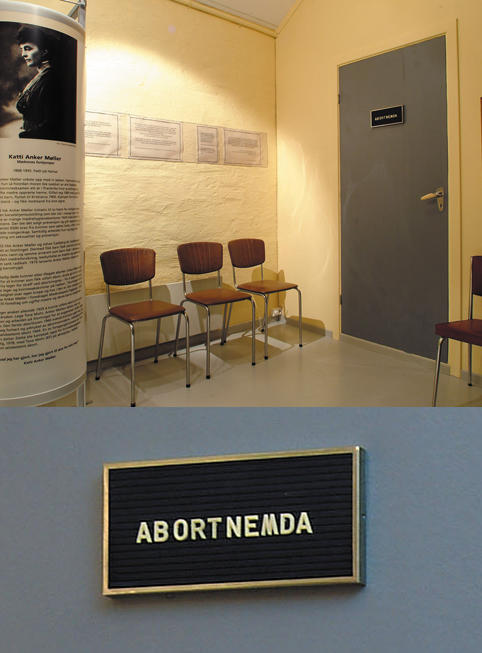- 1/1
Venterommet hos abortnemnda. Fra utstillingen 'Fortiet. Aborthistorien'
Because more abortions were now performed in hospitals, the visible number of abortions rose. However, there were fewer abortions on the whole, as contraceptions and information about contraception was improved.
The fury directed towards the appeals boards and their discriminating treatment of cases grew together with the rise of a youthful protest movement in Europe. Many found that England, with the most free abortion laws in Europe, was the only way out. The Norwegian Labour Party made the fight for the right to abortion upon request a part of their political agenda in 1969.
Doctor Berthold Grünfeld made a comprehensive study called "Legal abortions in Norway between 1965 and 1971" ("Legalt svangerskapsavbrudd i Norge i tidsrommet 1965-1971". The results of this study had a great impact on the politicians' decisions.
Woman with child can be permitted to remove the foetus:
1. When it is neccessary to save the life or health of the woman. When considering whether the woman is in danger of this, one should take into consideration whether or not the woman is disposed to particular physical or psychological illness, and also her life situation and other circumstances, which might make her ill or be detrimental to her physical and psychological health.
2. When there is serious risk of:
a) inherited defect in one of the parents, or
b) the woman is taken ill while pregnant, or
c) an injury to the foetus in the womb can lead to serious handicap, physical deformation or mental defect in the child.
3. When there is reason to belive that the woman was made pregnant in an offensive situation, under circumstances mentioned under Penal Law §§207-208, and also when the woman is mentally ill or has particularly poor mental faculties.
The debate raged on. Supporters and opponents alike mobilized. Lobbying groups were created across political borders, the People's Campaign against Abortion upon Request ("Folkeaksjonen mot selvbestemt abort") held petitions, and the Christian Democrat Party did not even want to accept abortions in incestious cases.
In 1973, the Norwegian Labour Party, the Norwegian Socialist Left Party, and the Workers' Communist Party promised to make the abortion debate part of the election campaigns. The demand grew stronger and the politicians were under more pressure than ever. The Women's Campaign for Abortion upon Request ("Kvinneaksjonen for selvbestemt abort") was created in 1974, as was the Information Committee for Abortion upon Request ("Opplysningsutvalget for selvbestemt abort", which consisted of medical professionals with connections to the Labour Party and the Socialist Left. Norways first female prime minister, Gro Harlem Brundtland, was among the members. The supporters lost the victory to the opponents in 1974.

Teacher, politician and Tove Mohr's daughter
Active politician for the Labour Party, and stated to the Parliament that "No child in Norway should be born unwanted". When the law legalizing abortion upon request was passed in 1978, she was present, together with her mother.
